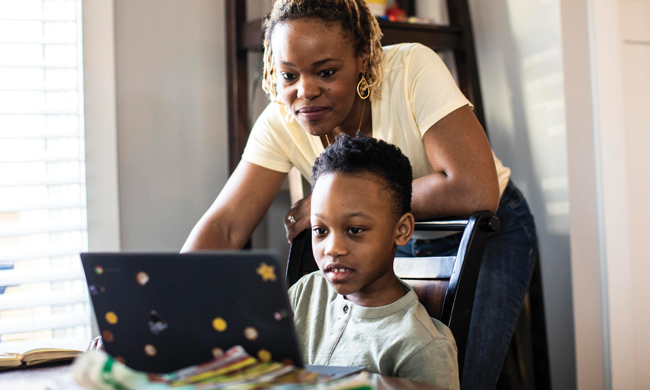child education
Spilling the Secrets to Early Literacy
Reading is critical for young children’s educational journeys, impacting their cognitive abilities, language proficiency, and later academic achievement.

(Family Features) For young children, learning to read is a critical step in their educational journeys, as literacy helps build cognitive abilities and language proficiency and has a direct impact on later academic achievement.
While there are no shortcuts to early literacy, there are steps parents can take to promote the development of children’s reading abilities. Dr. Lauren Loquasto, senior vice president and chief academic officer at The Goddard School, and Steve Metzger, award-winning author of more than 70 children’s books, share this guidance for parents.
Get Started Early
It’s never too early to start reading with children. In fact, they respond to being read to prenatally. One of the best ways to encourage early literacy is modeling the act of reading. Young children love to imitate, and if they see their parents reading, they are more likely to want to read themselves. Instead of scrolling on your phone or watching television while your children play, pick up a book or magazine.
Use Conversation to Build Literacy
To help build their vocabularies, consistently engage children in conversation. Literacy is more than reading and writing; it’s also listening and speaking. Children understand words before they can articulate them, so don’t be discouraged if it feels like a one-way conversation.
Expose Children to More Than Books
Make your home environment print-rich, as the more exposure children have to letters and words, the better. For example, keep magnetic letters and words on the fridge, put labels on your toy containers and position books and magazines in different rooms. Also remember reading isn’t limited to books. Words are everywhere, from street signs to restaurant menus. Take advantage of every opportunity to connect with your children through words throughout your day.
Let Them Take the Lead
Children engage with books in different, developmentally appropriate ways. Some children quickly flip through pages or only look at pictures while others might make up stories or their own words or songs. Some only want to read the same book over and over and some want to read a new book every time. Embrace and encourage their interest in books, no matter how they choose to use them.
Establish a Routine
Parents of young children often have busy and hectic lives, so it isn’t always easy to find time to read. Consistency is key, so be intentional about setting aside time for reading every day – perhaps it’s after dinner or before bedtime – and stick to it.
Select the Right Books
Helping young children choose books is an important part of their learning-to-read process. Developmental appropriateness is critical. For infants and toddlers, start with nursery rhymes, which are mini-stories that grasp children’s attention through repetition, rhythm and rhyming. Visuals are also important because they aren’t yet pulling words off the page. For emerging readers, choose books that align with their interests. Focus on books that are printed with text that goes from left to right and top to bottom.
Expose children to both fiction and non-fiction books. Non-fiction provides real-world knowledge children crave and helps them make sense of what they read in fictional stories. For example, the learnings about the life cycle of a bat they read in “Bat Loves the Night,” a non-fiction book, can help them better understand what’s happening in “Stellaluna,” a fiction book about a young bat.
If you’re in doubt about book choices, consult with a teacher or librarian, who can make recommendations based on your children’s interests and reading levels.
Foster a Love of Reading
Children’s early exposure to books can set the stage for a lifetime of reading. Make reading a time for discovery. Take children to a library or bookstore and encourage them to explore and find books on their own. Display genuine interest in their selections and use books as a tool for engaging and connecting with them. Don’t pressure children to learn how to read. Accept, validate and encourage them as they progress on their unique literacy journeys.
To watch a webinar recording featuring Loquasto and Metzger providing additional literacy guidance and recommendations, and access a wealth of actionable parenting insights and resources, visit the Parent Resource Center at GoddardSchool.com.
Photos courtesy of Shutterstock
SOURCE:
The Goddard School
https://stmdailynews.com/category/lifestyle/
Discover more from Daily News
Subscribe to get the latest posts sent to your email.
Blog
The Substitute Teacher Who Wanted Blueprints of Our House
A fifth-grade assignment took a strange turn when a substitute teacher asked students to draw schematics of their homes. What followed — a wildly fictional floor plan and a priceless reaction from my mom — turned into one of my funniest childhood memories.
Last Updated on December 8, 2025 by Daily News Staff
The Substitute Teacher Who Wanted Blueprints of Our House
Elementary school memories tend to blend together — cafeteria pizza, playground arguments, the eternal struggle of times tables — but every once in a while, something happens that sticks with you for life. For me, that moment came in the fifth grade during a week when our regular teacher was out, and we cycled through substitute teachers like we were testing models for durability. By midweek, in walked a substitute with a mysterious, slightly intense energy — the kind of vibe that suggested he either meditated at dawn or worked a graveyard shift doing something he couldn’t talk about. We settled into our seats, expecting worksheets or quiet reading time. But nope. He had other plans. “Today,” he announced, “we’re going to draw schematics of our houses.” Schematics. Not drawings. Not little houses with smoke coming out of the chimney. Actual blueprint-style schematics. He wanted the layout of our bedrooms, our parents’ rooms, and where the pets slept. Every detail. Now, to be fair, Highlights Magazine did have a feature that month teaching kids how to draw floor plans. So maybe he was just a bit overenthusiastic about cross-curricular learning. Or maybe — and this is my completely rhetorical adult theory — he worked the graveyard shift as a cat burglar gathering intel between heists. Just moonlighting between blueprints. While the rest of the class tried their best to recreate their actual homes, my imagination sprinted in a totally different direction. The house I drew had:- A massive master bedroom with an oversized bathroom for my parents
- Separate bedrooms for us kids on the opposite side of the house
- A kitchen placed right in the center like a command center
- And the dog — the true VIP — had a luxurious two-story doghouse
Enjoy this story?
Check out more nostalgic and humorous stories on STM Daily News and be sure to sign up for our newsletter!Our Lifestyle section on STM Daily News is a hub of inspiration and practical information, offering a range of articles that touch on various aspects of daily life. From tips on family finances to guides for maintaining health and wellness, we strive to empower our readers with knowledge and resources to enhance their lifestyles. Whether you’re seeking outdoor activity ideas, fashion trends, or travel recommendations, our lifestyle section has got you covered. Visit us today at https://stmdailynews.com/category/lifestyle/ and embark on a journey of discovery and self-improvement.
Discover more from Daily News
Subscribe to get the latest posts sent to your email.
Lifestyle
Preparing for the Future of Work: Tips to help teens choose a career path
Preparing for the Future of Work: American teens are optimistic about their careers despite concerns over AI’s impact. Many value internships and real-world experience over degrees, and are weighing passion against pay, seeking balance in their future career choices.
Last Updated on December 2, 2025 by Daily News Staff
Preparing for the Future of Work: Tips to help teens choose a career path
(Family Features) American teens are preparing for a workforce shaped by AI, new approaches to education and economic uncertainty. While challenges are real, optimism remains high.
In fact, 94% of teens said they are optimistic about their future careers, reflecting a strong sense of hope and ambition, according to research from Junior Achievement and Citizens. The two organizations have partnered for more than 18 years to advance financial empowerment nationwide, with the bank allocating funding and volunteer support, including more than $630,000 in 2025 to support financial empowerment programs that give people the confidence and tools they need to budget, save, invest and pursue their goals.
However, 57% of teens surveyed believe AI has negatively impacted their career outlook, raising concerns about job replacement and the need for new skills.
“Today’s teens face a rapidly changing world, from the rise of AI to shifts in education and careers,” said Susan LaMonica, chief human resources officer at Citizens. “The survey shows they know the importance of adaptability and continuous learning.”
To help teens build skills for emerging roles and navigate their futures, consider these tips from the experts at Junior Achievement, the world’s largest organization dedicated to giving young people the knowledge and skills they need to own their economic success, plan for their futures and make smart academic and economic choices.
Explore Internships
Success depends on more than credentials alone. Survey respondents believe networking (50%) and internships (41%) are keys to future success. What’s more, 56% believe real-world experience is more valuable than a four-year degree. Internships can provide that experience and allow students to test their interest in a field while building their professional networks, developing skills that can be applied to a range of career paths, identifying strengths and weaknesses and clarifying future goals.
Consider Post-High School Education
Teens’ perspectives on education reflect their uneasiness. Only 40% of teens surveyed believe a four-year degree is always a good investment. At the same time, about 6 in 10 believe a bachelor’s or graduate degree is still necessary for their chosen profession, which shows how complicated these decisions can be. While many careers require a college diploma, that isn’t the only path to career success. In addition to traditional four-year universities, consider alternate education paths such as trade schools or technical programs, apprenticeships, two-year degree programs or professional certifications if applicable to your career path.
Weigh Passion Against Pay
While most teens surveyed (63%) said they would prefer a good-paying job even if it comes with stress, many are weighing passion against pay as they explore career opportunities. In fact, some top industries in which teens plan to pursue a job include health care and life sciences (30%), arts and music (27%) and content creation and digital media (25%), further showcasing that willingness. Many students are also exploring less traditional routes to build security and opportunity, with 87% expecting to earn extra income through side hustles, gig work or social media content creation.
“The data illustrates how the stressors on young people are compounding year after year,” said Tim Greinert, president of Junior Achievement USA. “It also shows how resilient and savvy students are these days in terms of understanding the world around them and deciphering the best path to the future that’s best for them.”
To learn more about preparing for future success and find full survey results, visit JA.org/FutureOfWork.
Photo courtesy of Shutterstock
SOURCE:
STM Daily News is a vibrant news blog dedicated to sharing the brighter side of human experiences. Emphasizing positive, uplifting stories, the site focuses on delivering inspiring, informative, and well-researched content. With a commitment to accurate, fair, and responsible journalism, STM Daily News aims to foster a community of readers passionate about positive change and engaged in meaningful conversations. Join the movement and explore stories that celebrate the positive impacts shaping our world.
Discover more from Daily News
Subscribe to get the latest posts sent to your email.
Lifestyle
Tech Time: Technology-enabled devices for parents and children
Last Updated on November 3, 2025 by Daily News Staff
(Family Features) Encouraging a successful education for your kids while promoting fun after-school learning may never be easier than right now. From wearables to virtual reality headsets and beyond, the latest tech-enabled devices let families enhance classroom experiences while engaging in downtime together after the final school bell rings.
Find more gadgets to help families balance learning and pleasure this school year at qualcomm.com.
First Work Then Play
A practical choice, the Lenovo Duet 3 Chromebook is an ideal work and play device for a hyper-mobile student, delivering superior experiences with an 11-inch 2K near-borderless display. Faster connectivity options, all-day battery life and the powerful, fanless and efficient performance of the Snapdragon 7c Gen 2 Compute Platform ensure things get done. Thanks to the speedy, secure and simple-to-use Chrome OS, you can tackle tasks on this 2-in-1’s detachable keyboard with anti-pry, water-resistant keys then seamlessly switch to pleasure pursuits by folding into tablet mode.
Lightweight, Powerful Computing
Weighing in at less than 1.2kg, the convertible Acer Chromebook Spin 513 is not only light but also barely larger than a sheet of paper so it slips easily into any compact bag or backpack. Powered by the Snapdragon 7c Compute Platform, it delivers more than enough processing power, battery life and reliable connectivity to get you or your student through the day. A quick flip between laptop and tablet modes means it can be used to doodle, watch classroom instruction and learn on the go. Built-in cellular connectivity means the device seamlessly converts between 4G LTE and trusted Wi-Fi networks.
Wearable Connectivity
Powered by the Snapdragon Wear 2500 Platform, the Gabb Watch is a safe wearable phone for kids that does extra duty as a GPS tracker, phone and interactive smartwatch. The watch offers kid-friendly sweat and dirt resistance and enables GPS tracking, calling, voice and text messaging to help parents and kids stay connected. With a lock mode, safe zone location management and emergency notifications, it’s a smart first step toward independence for junior users.
Headset Hero
Designed from the ground up to drive advanced features, Snapdragon XR2 is the force behind the Meta Quest 2 headset’s freedom of movement and high-resolution display. This headset allows families to become completely immersed in the virtual reality applications and games played for maximum adventure experiences. Even better, hundreds of hit games, one-of-a-kind experiences and a growing community await users of this next-level hardware that’s both easy to set up and safe to use.
A Phone to Keep Everyone Connected
Choosing a phone means looking for the fastest speeds, highest resolution camera, loudest audio and boldest display.Powered by the latest Snapdragon 8 Gen 1 Mobile Platform processor, the motorola edge+ (2022) delivers. This industry-leading smartphone is a high-performance choice that brings unparalleled processing power on the industry’s fastest mobile platform, fueling cutting-edge 5G, AI, gaming, camera and Wi-Fi and Bluetooth technologies. What’s more, features like extended battery life and 512 GB of storage mean your phone is ready whenever you are.
Photo courtesy of Getty Images (Mom and Son)
SOURCE:
Qualcomm
Our Lifestyle section on STM Daily News is a hub of inspiration and practical information, offering a range of articles that touch on various aspects of daily life. From tips on family finances to guides for maintaining health and wellness, we strive to empower our readers with knowledge and resources to enhance their lifestyles. Whether you’re seeking outdoor activity ideas, fashion trends, or travel recommendations, our lifestyle section has got you covered. Visit us today at https://stmdailynews.com/category/lifestyle/ and embark on a journey of discovery and self-improvement.
Our Lifestyle section on STM Daily News is a hub of inspiration and practical information, offering a range of articles that touch on various aspects of daily life. From tips on family finances to guides for maintaining health and wellness, we strive to empower our readers with knowledge and resources to enhance their lifestyles. Whether you’re seeking outdoor activity ideas, fashion trends, or travel recommendations, our lifestyle section has got you covered. Visit us today at https://stmdailynews.com/category/lifestyle/ and embark on a journey of discovery and self-improvement.
Discover more from Daily News
Subscribe to get the latest posts sent to your email.

